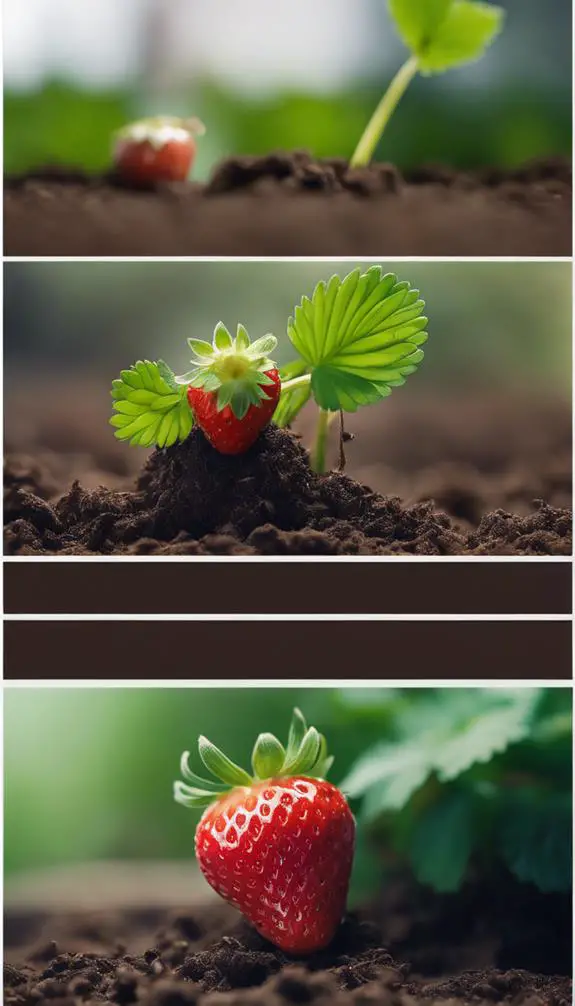As you begin your journey to grow sweet peppers, you'll soon discover that it's not just about throwing some seeds in the ground and waiting for magic to happen. To yield a bountiful harvest, you'll need to carefully select the right variety, prepare the soil, and provide ideal growing conditions. But that's just the beginning. You'll need to support your plants, prune for better yield, and keep a watchful eye out for pests and diseases. And even then, there are still some vital steps to take to guarantee you're harvesting sweet, juicy peppers at the peak of flavor.
Summary
- Choose the right sweet pepper variety based on growth habit, fruit size, color, and sweetness level for a successful harvest.
- Prepare the soil by testing its pH level and nutrient content, and creating a nutrient-rich mixture for healthy growth.
- Provide optimal growing conditions, including intense sunlight, consistent moisture, and perfect humidity, to promote healthy growth and fruit production.
- Support pepper plants as they grow using stakes or cage trellises, and prune them to encourage branching and maximum yield.
- Monitor plants regularly for pests and diseases, and take corrective action to prevent infestations and infections.
Choosing the Right Variety
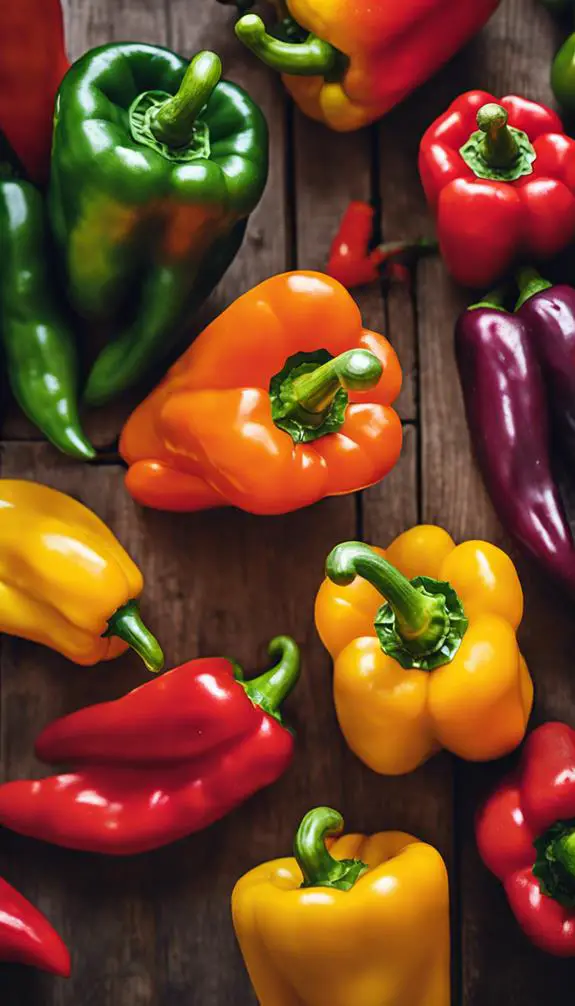
Selecting the ideal sweet pepper variety is crucial for a successful harvest, as different types vary markedly in terms of growth habit, fruit size, color, and sweetness level.
You'll want to ponder the sweet pepper types that suit your climate, available space, and desired pepper flavor profiles.
Bell peppers, for instance, are sweet and crunchy, while sweet mini peppers are perfect for snacking.
If you're looking for a more intense flavor, ponder growing sweet cherry peppers or pimento peppers.
Some varieties, like Cubanelle or Banana peppers, offer a sweet, slightly smoky taste.
Preparing the Soil
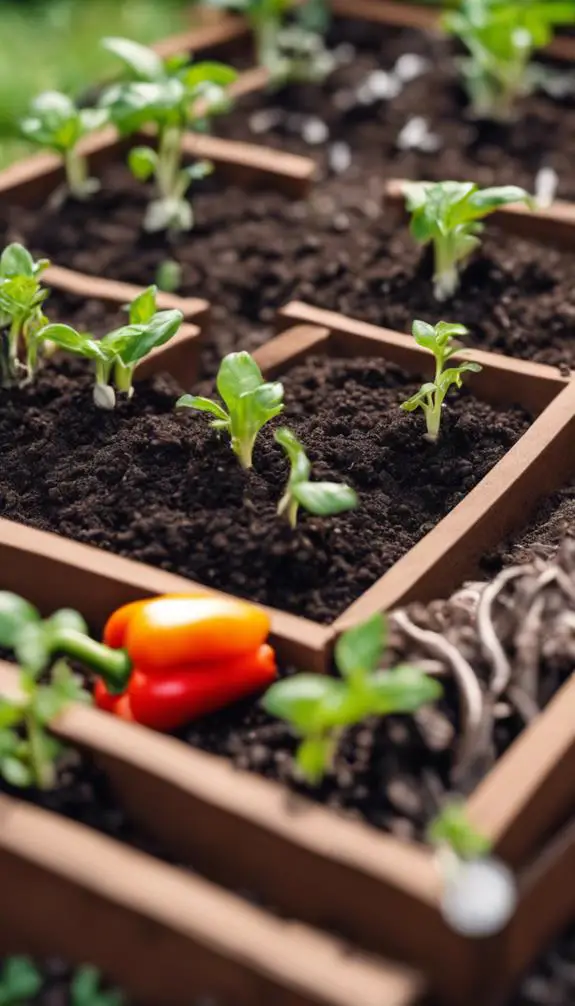
You'll want to start by testing your soil to determine its pH level and nutrient content, as sweet peppers require a well-balanced soil to thrive.
Next, you'll need to create a nutrient-rich mixture that provides the necessary foundation for healthy growth.
Soil Testing Essentials
To guarantee ideal growth for your sweet peppers, the soil must be properly prepared, which begins with understanding its composition.
You'll want to test the soil to determine its pH level, nutrient content, and structure.
A well-balanced soil structure is pivotal, as it affects water retention, aeration, and root growth.
Microbe activity also plays a essential role, as beneficial microbes help break down organic matter and make nutrients available to your sweet peppers.
By analyzing these factors, you'll be able to identify any deficiencies and take corrective action.
This will secure your soil provides the prime environment for your sweet peppers to thrive.
Nutrient Rich Mixtures
About two-thirds of your sweet pepper's roots grow in the top 6-8 inches of soil, making it crucial to create a nutrient-rich mixture that fosters healthy root development.
To achieve this, you'll want to incorporate organic amendments into your soil. These can include compost, well-rotted manure, or worm castings, which provide essential micronutrients and improve soil structure.
Consider creating a custom blend that suits your specific soil type and sweet pepper variety. Aim for a mix that's rich in organic matter, with a balanced ratio of nitrogen, phosphorus, and potassium. By doing so, you'll be providing your sweet peppers with the ideal environment to thrive.
Ph Balance Check
As you prepare the soil for your sweet peppers, a crucial step is to check the pH balance.
You'll need a pH meter, which requires calibration before use. Follow the manufacturer's instructions for pH meter calibration to guarantee accurate readings.
Sweet peppers prefer a slightly acidic to neutral soil pH, ranging from 6.0 to 7.0.
If your soil pH is too high or too low, it can lead to acid alkalinity issues, affecting nutrient availability. For instance, a pH below 6.0 can cause aluminum toxicity, while a pH above 7.0 can lead to calcium and magnesium deficiencies.
Sowing Seeds Indoors

Six to eight weeks before the last frost date in your area, start sowing sweet pepper seeds indoors.
You'll want to guarantee seed freshness for peak germination rates. Check the package for the "packed for" date or store seeds in an airtight container in the refrigerator to maintain viability.
Fill seed trays or small pots with a well-draining seed starting mix, and moisten it with lukewarm water.
Sow seeds at the correct sowing depth, typically ¼ inch deep. Cover the seeds with a thin layer of the mix. Water gently but thoroughly, and provide adequate light and warmth (around 75-85°F) for germination.
Transplanting Seedlings Outdoors

You're now ready to transplant your sweet pepper seedlings outdoors, but before you do, you'll need to choose a spot that receives full sun and has good air circulation.
Next, you'll need to prepare the soil bed by loosening it to a depth of 12-18 inches and adding organic matter like compost or well-rotted manure.
Choosing the Right Spot
Transplanting seedlings outdoors requires careful planning to guarantee sweet pepper plants thrive.
You'll want to choose a spot that receives full sun, at least 6 hours of direct sunlight, and has good air circulation to prevent disease.
Climate considerations are vital, as sweet peppers are sensitive to temperature fluctuations.
Aim for a location with a consistent temperature between 65°F and 75°F.
Create a microclimate by using row covers or cold frames to regulate temperature and humidity.
Avoid areas with standing water or where water tends to collect, as this can lead to root rot.
Preparing the Soil Bed
With your sweet pepper plants' ideal location secured, it's time to focus on preparing the soil bed for transplanting.
You'll want to create a perfect environment for your seedlings to thrive. Start by loosening the soil to a depth of 12-18 inches, improving its structure and aeration. This allows roots to grow deeper, increasing their ability to absorb nutrients.
Next, add organic matter like compost or well-rotted manure to enrich the soil, supporting the growth of beneficial soil microorganisms. These microorganisms play a vital role in breaking down nutrients, making them available to your sweet pepper plants.
Harden Off Seedlings
Seven to ten days before transplanting your sweet pepper seedlings outdoors, start hardening them off to guarantee a seamless shift.
Harden off your seedlings by gradually exposing them to outdoor conditions, increasing their exposure time each day. Begin by moving them to a shaded area outdoors for 1-2 hours, then bring them back indoors.
Gradually increase their outdoor time over the next few days, eventually leaving them outside overnight. This process will help prevent seedling shock and sunlight stress when you finally transplant them into their permanent soil bed.
Providing Optimal Sunlight
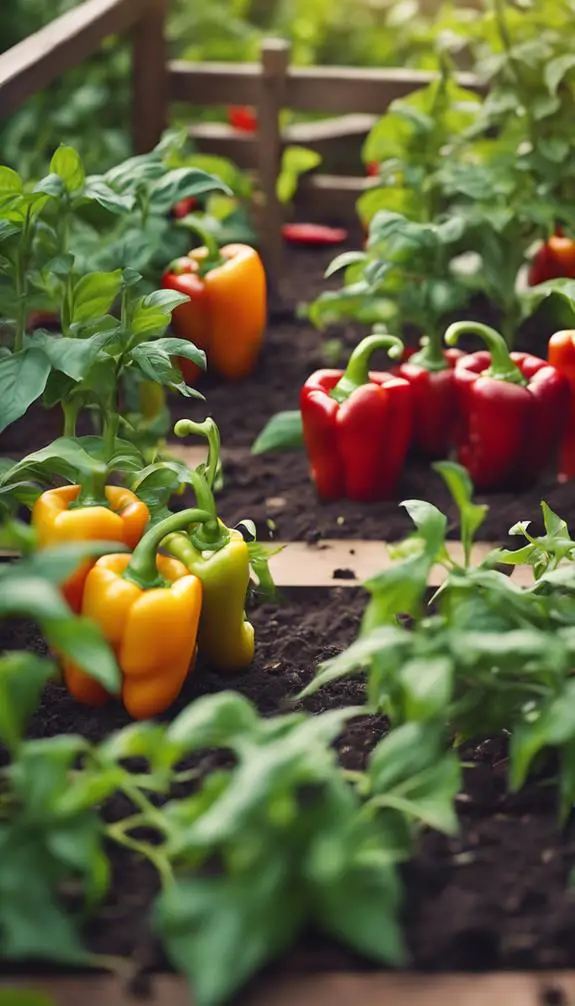
Your sweet pepper plants crave intense sunlight to produce an abundance of fruit, so this is vital to provide them with the ideal amount of direct sun.
Aim for at least six hours of direct sunlight daily, as this will boost sunlight intensity and promote healthy growth. Consider the window orientation in your growing space, as south-facing windows receive the most intense sunlight.
East- and west-facing windows also work well, but north-facing windows may not provide sufficient sunlight. If you can't provide direct sunlight, consider using grow lights to supplement the natural light.
Watering and Humidity
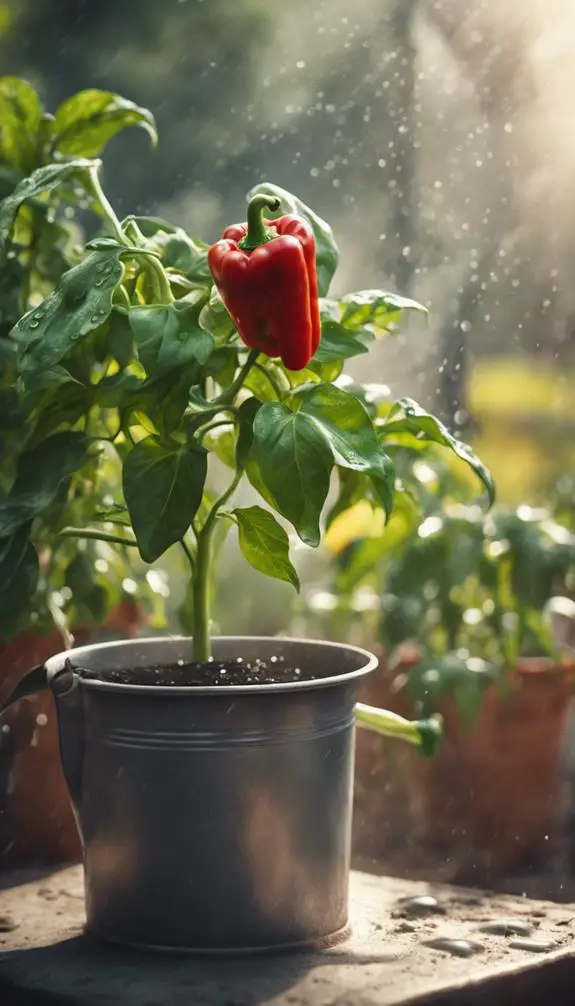
Since sweet pepper plants are sensitive to moisture levels, achieving ideal conditions requires striking a balance between adequate watering and maintaining ideal humidity.
You'll want to guarantee the soil has consistent moisture, but not waterlogged. Implement water retention methods like mulching or using hydrophilic polymers to regulate moisture levels.
To monitor soil moisture, utilize advanced moisture monitoring tools such as soil probes or tensiometers. These tools provide precise readings, allowing you to adjust your watering schedule accordingly.
By maintaining perfect humidity, usually between 40-60%, you'll promote healthy growth and prevent diseases. Be cautious not to overwater, as this can lead to root rot and other issues.
Fertilizing Sweet Peppers
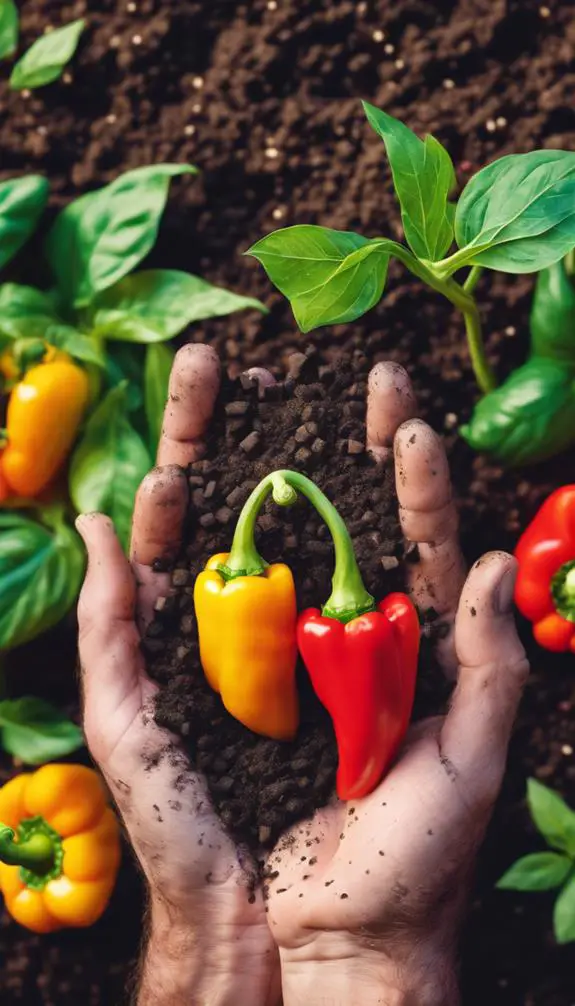
You'll need to guarantee your sweet pepper plants have a balanced soil nutrient profile to promote healthy growth and fruit production.
You can achieve this by maintaining ideal levels of essential macronutrients like nitrogen, phosphorus, and potassium, as well as micronutrients like calcium and magnesium.
Soil Nutrient Balance
Sweet pepper seedlings thrive in a nutrient-rich soil environment, where a delicate balance of macronutrients and micronutrients fuels their growth.
You'll want to create an ideal soil structure that allows for efficient nutrient cycling. Aim for a well-draining soil mix with a pH between 6.0 and 6.8.
This will facilitate the uptake of essential nutrients like nitrogen, phosphorus, and potassium. Additionally, incorporate organic matter like compost or manure to enhance soil fertility and promote beneficial microbial activity.
This will help maintain a balanced nutrient profile, ensuring your sweet peppers receive the necessary nutrients for robust growth and maximum flavor. By achieving this delicate balance, you'll be rewarded with a bountiful harvest of sweet, crunchy peppers.
Essential Mineral Supplements
The foundation of a nutrient-rich soil environment is pivotal for sweet pepper growth, and essential mineral supplements play a key role in maintaining this balance.
You'll want to focus on providing your sweet peppers with the necessary micronutrients, particularly Magnesium and Calcium. Magnesium benefits include enhanced photosynthesis, increased flower and fruit production, and improved plant resilience.
A Calcium boost, on the other hand, promotes healthy cell wall development, reduces blossom-end rot, and supports overall plant structure.
Supporting Peppers as They Grow

How can you guarantee your pepper plants receive the necessary support as they grow, especially when they start producing heavy fruit?
One effective method is to use pepper stakes, which provide individual support to each plant. Simply drive the stake into the soil near the base of the pepper plant and gently tie the stem to the stake using a soft material like twine or cloth.
Another option is to use a cage trellis, which surrounds the plant with a sturdy structure that allows the pepper plant to grow upwards while providing support for the fruit.
Pruning for Better Yield

Can you imagine harvesting a bounty of peppers from a single plant?
Pruning is a vital step to achieve this goal. By pruning your sweet pepper plant, you're encouraging fruit growth and shaping the plant for maximum yield.
Remove lower leaves to prevent fungal diseases and promote air circulation. Cut back the terminal bud to encourage branching, which will lead to more fruiting sites.
Remove any weak or spindly growth to direct the plant's energy towards producing fruit. This precise pruning technique will stimulate fruit encouragement and promote pepper shaping, resulting in a more productive and healthy plant.
Controlling Pests and Diseases
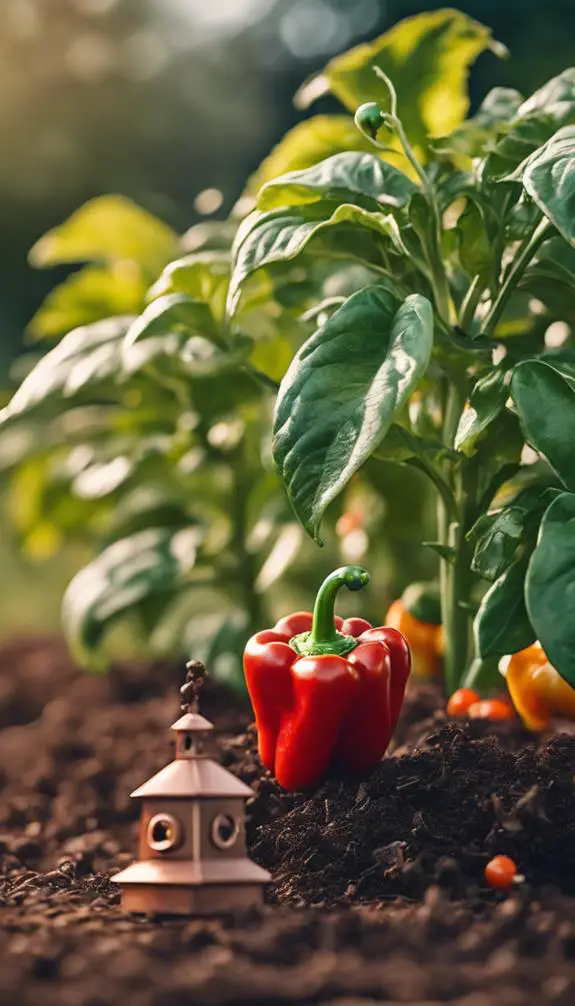
As you nurture your sweet pepper plant towards peak fruit production, pests and diseases can quickly undermine your efforts, so it's crucial to stay vigilant and take proactive measures.
Implement a pest monitoring system to detect early signs of infestation, allowing you to respond promptly. Regularly inspect your plants for signs of disease, such as yellowing leaves or black spots.
Organic pesticides, like neem oil and pyrethrin, can be used to control pests without harming beneficial insects. Prevent disease spread by removing infected leaves or stems, and maintaining good air circulation around your plants.
Pollination and Fruit Set

Three to five weeks after transplanting, your sweet pepper plants will start flowering, marking the beginning of the pollination and fruit set process.
During this stage, you'll notice Vibrating Bees buzzing around the flowers, collecting nectar and pollen. As they move from flower to flower, they transfer pollen, facilitating pollination.
You can enhance this process by gently vibrating the plants or using a small electric device to generate gentle Electric Charges, mimicking the bees' vibrations. This stimulates the release of pollen, increasing the chances of successful pollination and fruit set.
Certify your plants receive adequate moisture and nutrients to support fruit development. By optimizing pollination and fruit set, you'll be rewarded with a bountiful harvest of sweet, juicy peppers.
Harvesting at the Right Time

Sweet peppers hang from the plant like colorful ornaments, signaling they're ready for harvest.
You've waited patiently for this moment, and now it's time to reap the rewards.
When it comes to harvest timing, pepper color is key.
Green peppers are typically ready to pick when they're firm and glossy, but they'll lack sweetness.
For sweeter peppers, wait until they've reached their full color potential – whether that's yellow, orange, red, or purple.
Harvest them when they're slightly soft to the touch, as over-ripe peppers can become bitter.
Check your plants regularly, as peppers can go from perfect to past their prime quickly.
Common Mistakes to Avoid
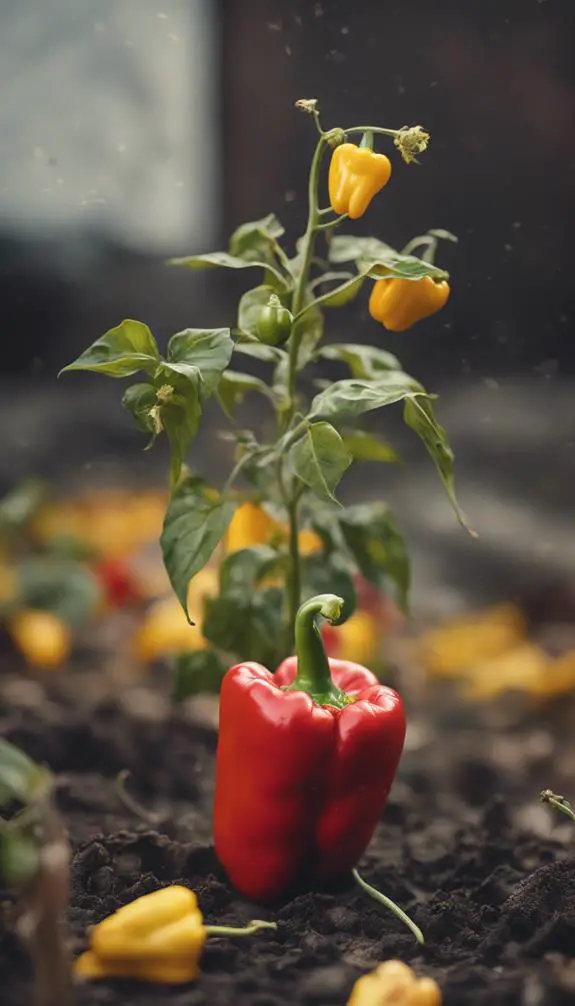
Growing sweet peppers requires attention to detail, and even experienced gardeners can make mistakes that compromise their harvest.
You'll want to avoid common pitfalls that have plagued sweet pepper enthusiasts throughout history. For instance, failing to provide adequate support can lead to weak, leggy plants, reducing your yield.
Insufficient spacing can spread disease, while overwatering can cause root rot. Ignoring pepper challenges like aphids, whiteflies, and spider mites can decimate your crop.
Additionally, neglecting to rotate your pepper patch can lead to soil depletion and reduced flavor.
FAQs
Can I Grow Sweet Peppers in Containers?
You can grow sweet peppers in containers, but make sure they're at least 12-18 inches deep to accommodate the roots. Use high-quality soil with good drainage and a pH between 6.0-6.8 for ideal growth and fruit production.
How Do I Store Sweet Peppers for Longer Freshness?
When storing sweet peppers, you'll achieve longer freshness by utilizing freezer storage, where they'll retain flavor and texture for up to 8 months, or dehydration methods, such as freeze-drying or dehydrating, to preserve their nutritional value.
Can I Grow Sweet Peppers Indoors Year-Round?
You can successfully grow sweet peppers indoors year-round by utilizing advanced indoor lighting options, such as LED grow lights or hydroponic systems, and investing in climate control systems that regulate temperature and humidity.
Do Sweet Peppers Need to Be Rotated Annually?
You'll want to rotate your sweet pepper crop annually to avoid soil depletion, as consecutive plantings can lead to nutrient deficiencies and reduced yields, making crop rotation a vital step in maintaining peak soil health.
Can I Save Seeds From Sweet Peppers for Replanting?
You can save seeds from sweet peppers, but guarantee seed viability by drying and storing them properly to preserve freshness, as poorly stored seeds may not germinate or produce healthy plants.
Conclusion
You've successfully navigated the process of growing sweet peppers! Now, enjoy the fruits of your labor by harvesting at the right time. Remember to monitor and maintain ideal growing conditions to guarantee a bountiful yield. Avoid common mistakes, and don't hesitate to troubleshoot any issues that arise. With proper care, your sweet peppers will thrive, providing a delicious and nutritious addition to your favorite recipes.


